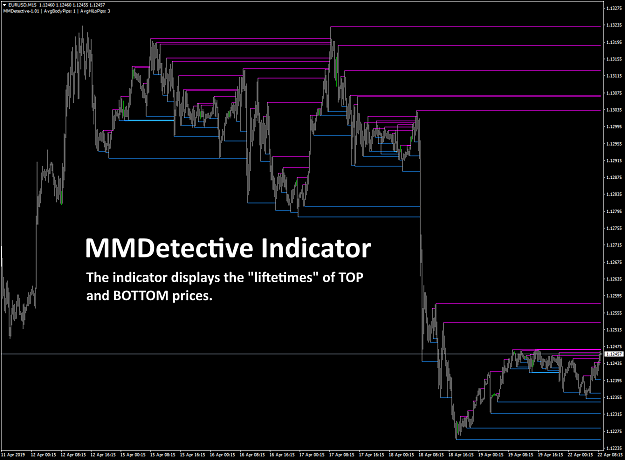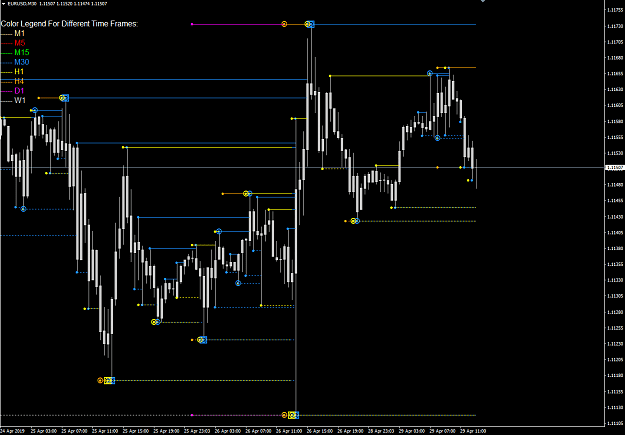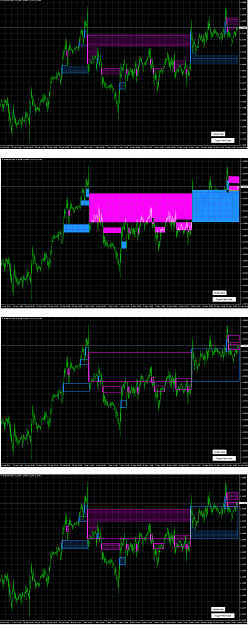- 六月 4, 2019
- 投稿者: 外国為替Wikiチーム
- カテゴリー: 外国為替取引システム

スレッド上で "MM (マーケットメーカー) 探偵インジケーター" (https://www.forexfactory.com/showthread.php?t=911239) カスタマイズされたインジケーターの収集の量が増加し、送信で処理するには膨大な数になりました #1 . So I've determined to park them right here. これは読み取り専用のスレッドであり、新しいリリースを発表できる場所です。, updates and add the most recent variations. Please don't publish on this thread.
Here's a hyperlink to the most recent (最高) variations of all the symptoms. As time permits, I may also try to consolidate documentation in *.pdf recordsdata:
MM (Market-Maker) 探偵インジケーター
MM刑事 exhibits the "生涯" of TOPS and BOTTOMS on a worth chart.

Wanting on the worth chart from left-to-right, the purple traces start at a TOP and prolong to the precise till they're "taken-out" or eliminated by the worth transferring upward. 同様に, the blue traces start at a BOTTOM and prolong to the precise till they're "taken-out" by the worth transferring downward. Utilizing this indicator you may clearly see the "生涯" of TOPS and BOTTOMS.
A TOP happens when the worth strikes downward. A BOTTOM happens when the worth strikes upward. 停止損失は価値ラインの上下に蓄積されます. クイックトレードの場合 (促進する), 停止損失は価値ラインを超えて蓄積します, 長期取引の場合 (買い物), 停止損失は価値ラインの下に蓄積されます. When the MM initiates a spike upward, クイックトレードによる損失は取り消されます. When the MM initiates a spike downward, 長期取引による損失は相殺されます.
The sample of ranging or trending costs adopted by a spike happen over and over once more -- each image and timeframe. さらに the size of the spike could be very precise -- simply lengthy sufficient to take-out the focused Cease Losses -- no extra and no much less.
MM Detective MTF-HLF Indicator ('MTF' refers to multi-time body, 'HLF' refers to higer-level fractals).
This model consists of help for each MTF (a number of time frames) and HLF (higher-level fractals). MTF had at all times been within the works, however HLF was not. It was lately launched to me by @SwingMan -- so he deserves all of the credit score. My sense is higher-level fractals do a greater job detecting TOPS and BOTTOMS -- we'll see.

MM Liquidity Gaps Indicator
Liquidity gaps -- additionally known as "hidden" gaps -- replicate unfilled (untransacted) BUY or SELL orders. My working speculation, till somebody comes up with one thing higher, is the MM needs to transact these orders. さらに, the one technique to earn a living in foreign exchange is for costs to maneuver vertically up and down, and as a way to transfer up and down there have to be liquidity. Whether or not the MM manipulates costs to maintain liquidity fluid or whether or not it manipulates costs to forestall world-wide commerce from shutting down, I do not know. Regardless, liquidity is significant.
Since there are a set variety of items of every foreign money then each BUY have to be matched by a SELL. Suppose a big BUY order is available in at a sure worth, however there are not any items of that foreign money out there at that worth. The MM has to shake the tree a bit to reap some items to fulfill the BUY order. That is the place the manipulation comes into play while you see how goal ranges are created to lure merchants in a single path or the opposite -- the objective being to shut them out, free-up items of foreign money, and present liquidity essential to transact unfulfilled orders. I do not know for certain whether or not that is the way it all works -- however for now it offers a context for me to clarify MM psychology.
From @George I've discovered about two varieties of targets:
(ある) Goal ranges (created by TOPS and BOTTOMS traces) which are created by the MM to lure merchants into pondering there are help or resistance ranges. The intent is to both encourage merchants to open a brand new place or regulate their cease loss (for later harvesting by the MM).
(b) Liquidity gaps -- costs that have to be revisited as a result of unfilled orders stay to be transacted.
The MMDetective indicators had been created to assist determine the goal ranges created by TOPS and BOTTOMS traces.
The MMLiquidityGaps indicator was created to detect liquidity gaps which are sometimes laborious to detect by eye.
Liquidity gaps might be displayed as traces (which I favor) or as bins. Bullish liquidity gaps get stuffed when the MM pushes the worth down, whereas Bearish liquidity gaps get stuffed when the MM pushes the worth up. The rationale I favor traces is as a result of gaps usually are not essentially stuffed by a single worth motion -- that's, the MM could take a number of bites out of the hole and it's simpler to see this with traces. The pictures under present a taste of what I imply:

MM Zone2 Indicator
MMZone2Indi might be fairly completely different than most others you're accustomed to. It divides a worth chart into two zones -- Zone #1 is the place the MM's manipulation and purchase / promote / stoploss fest happens, and Zone #2 is the aftermath of a liquidity hole the place the MM has "proven its hand". There is a crucial underlying assumption -- liquidity gaps get stuffed a really excessive proportion of the time (のように > 95%). If you happen to disagree with the assertion, then this indicator is NOT for you.

Newest model:
The *.zip file consists of the next indicators:
MMDetective.ex4
MMDetective-MTF-HLF.ex4
MMLiquidityGaps.ex4
MMZone2Indi.ex4
MMZone2Filter.ex4
MMAverageBarSize.ex4
MM-SessionsIndi.ex4
MM-ADRIndi.ex4
MM-ADRHistIndi.ex4
MM-TmaTrue-M1.ex4
I've included temporary descriptions of every of the symptoms under.


